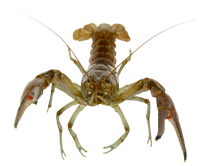Behavioral Neuroscience, lecture on Crayfish and its behavior
Escape - Crayfish
I. Crayfish Arthropod crustaceans in the Class: Malacostraca, Order: Decapoda
A. Crayfish (crawfish, crawdad, freshwater lobster)
1. Segmented body - exoskeleton
a. Appearance characterized by jointed head and thorax
i. Head has sharp snout
ii. eyes on movable stalks with two pairs of sensory antennae
iii. Four pairs of walking legs
(1) swimmerets
iv. pair of claw-bearing chelipids
(1) Front of body when moving
2. Growth requires molting
B. Worldwide Distribution (over 540 species)
1. More than half in North America (Kentucky, Louisiana, Mississippi Basin)
a. Common in streams and lakes
2. Most common Crayfish genera of North America
a. Procambarus, Orconectes, Faxonella, Cambarellos, Pacifastacus
b. nearly all live in freshwater
i. few can survive in salt-water
C. Ecology, Natural History, Survival
1. most active at night (variable depending on age)
a. Adults (1 year old) most active at dusk and during the night or cloudy days
b. Younger crayfish more likely out during bright sunny days
2. Feed on snails, algae, insect larvae, worms, tadpoles, water plants
a. Continue heavy feeding activity until daybreak
b. walking legs probe cracks and crevices for food
c. chelipids specialized for cutting, capturing food
3. Predators: Alligators, burbot, turtles, otter, and grackles
a. Conceal themselves under rocks and logs
i. Hard, jointed exoskeleton provides protection
ii. chelipids specialized for attack and defense
iii. rapid tail flips for escape
4. Short lives < 2 years
5. Rapid and high rates of reproduction
a. Eggs attached to female swimmerets on underside of jointed abdomen
i. 2-20 weeks for about 800 eggs to hatch
D. Behavior
1. General movement is always a slow walk
2. If startled: tail flips to escape danger
II. Escape Behavior
A. Rapid flips of the tail
1. rapidly contracting/bending abdomen and tail
2. moves animal in reverse through the water
a. away from what the crayfish is facing (including danger)
3. Escape Response used in dangerous situations
a. attack from predators
b. fights with other crayfish or if startled
B. Excited by strong, sudden stimulus to tail
1. Such as predator attack
C. Controlled by 3 neural circuits
1. Lateral, Medial, and Non-Giant circuits
2. Crayfish Nervous System
a. Nerve chain of 13 ganglia
b. Giant neurons
i. Medial Giant - dorsal and medial
1) pair of neurons in brain
2) axons run along dorsal margin of the crayfish nerve cord
ii. Lateral Giant - mediolateral
c. non-giant neuorns - ventral
